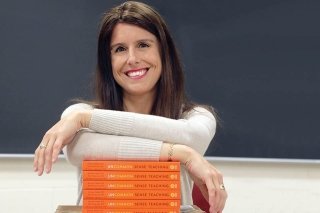Smart Teaching
Bloomsburg
Posted
Professor Co-Authors Book on the Science of Learning

As an educator, Beth Rogowsky is a veteran. And today, her
expertise is making a global impact on education.
“Growing up, I worked in our family’s child care center, and I learned early on that organizing toddlers for a picture can be a lot like herding cats,” says Beth Rogowsky, Ed.D. “After high school, I went on to college at BU (’96/’01M). Becoming a teacher was a natural fit, given all my hands-on training with the little ones.”
Before returning to BU, where she is a professor of teaching and learning, Rogowsky taught for more than a decade in rural and urban middle school classrooms and completed a three-year postdoc fellowship in neuroscience at Rutgers University.
The combination of hands-on teaching experience and scientific research made her the perfect co-author for the book, Uncommon Sense Teaching: Practical Insights in Brain Science to Help Students Learn, which is making waves in the teaching world. It’s sold more than 7,500 copies in the first six months of its release, ranks ninth on Amazon’s list of inclusive education books, and is being translated into eight languages.
“We need to start basing our teaching on the science of learning. Unfortunately, teacher education textbooks don’t typically include the neuroscience of what makes effective teaching, and if they do, they make sweeping generalizations that offer little insight. Likewise, most neuroscientists are not directly applying their research to education. There remains a disconnect—until now,” says Rogowsky, a Danville, Pa., native and first-generation college student.
Uncommon Sense Teaching changes that. The book was written over a two-year period with neuroscientist Terrence Sejnowski and engineer Barbara Oakley, who teach the massive open online course, Learning How to Learn, with over 3 million enrolled. The co-authors met in late 2018, began writing in 2019, and devoted the fall of 2020 to editing. For the final three semesters of the process, Rogowsky used the book draft in her classes and got feedback from her students.
“There are a lot of trends in education that aren’t valid,” says Rogowsky. “Too many bells and whistles don’t work. Hands-on doesn’t necessarily mean minds-on. Active learning is about the pathways neurons make in your brain. Honestly, it has nothing to do with arts and crafts projects or excessive time on low-level regurgitating of basic facts and definitions.”
What does work?
“Direct instruction,” says Rogowsky, “the teacher presenting to the class for short periods of time. Coupled with guided practice and immediate feedback. Otherwise, students may repeat the same mistakes. For students to improve, they need the teacher’s feedback. When you look at how the brain works, we need repetition. That takes time. Time with built-in deliberate practice. We call it ‘drill to skill.’”
It’s an instructional strategy that will be familiar to any athlete or musician — fields where coaches and teachers rely on repeated drills to build “muscle memory.” The same principle works for academic subjects … repetition strengthens connections between neural links in the brain. Those strengthened neural connections mean that information becomes readily accessible when needed.
“My BU students’ feedback helped make the book clear and relatable,” says Rogowsky. “This is the book that I wish I had when I began my teaching career, but it couldn’t have been written in the 1990s because we needed to tap into the most recent neuroscience that wasn’t even available or known about in some cases until just a few years ago.”
But even non-teachers can find the book useful. “It’s a book about learning. There are strategies you can use to help yourself learn and to help your children learn.”
Rather than publish it as an expensive textbook, the trio opted to go through the challenging process of selling the concept to a leading mass-market publisher, Penguin Random House, so it would be affordable and accessible.
And today, the development of the internet means that the lessons of the book can also be found online as a MOOC (Massive Online Open Course) on Coursera.org with over 10,000 enrolled. “The MOOC is where the book really comes to life,” says Rogowsky.
“Back in the ’90s when I was sitting in the seats of McCormick as an undergrad, I dreamed I would make a difference to the field of education. I just had no idea that dream would lead to all this.”



